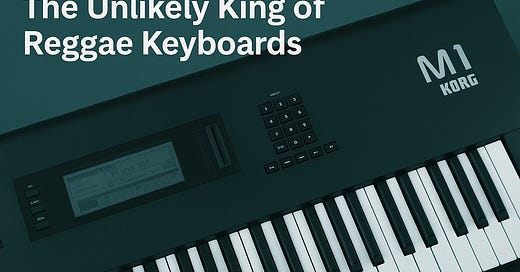The KORG M1 Piano: The Unlikely King of Reggae Keyboards
A sound I still can't stand, but that's just me
I was in my late teens when this new miracle of synths appeared in our home. My father, keyboardist with Janis Joplin, Martha Reeves, Pointer Sisters, brought this home. For me, this was like being let loose in a candy store. Throughout my life growing up, Pop would appear with new sonic toys for him and I’d immediately commandeer them and hide in the basement studio we built and get to work learning, writing and recording.
I’ve never been a technical guy, the one who pours through a manual savouring all the minutiae to maximize the products full potential. I’m the guy who turns it on, sifts through the presents and finds the ones that do the job. This machine changed that - it’s simplicity in the way things were presented - the sequencer, presets and maneuvering made me emboldened to began working the sequencer and get into writing short songs ideas. As you’d sift though the presets, the piano sound (it was very hard to find a quality piano preset on synths back then) popped up. To me it sounded cheap, plinky and with little depth, but I used it for lack of a better option. Oh I, with little lack of foresight, the one who could not have predicted that piano sound would come to dominate reggae and dancehall for a solid patch of years - each time, chipping away at my sanity. Was it just me that couldn’t stand this sound? Apparenety so as it went on to sell oner 250,000.
I had to ask me dad what happened to it. I’d spent countless hours with it, hunkered down in that dark abyss of joy - the studio where night and day merged into a solid room of blue smoke haze. Turns out he eventually gave it to jazz drummer Archie Alleyne (who played with Billie Holiday and others) which was then shipped to a school for kids in Africa. Too cool
When you think of legendary reggae gear, you might picture spring reverbs, tape echoes, and vintage organs. But one of the most iconic sounds in reggae—especially in dancehall and lovers rock—comes from a digital synth released in 1988: the KORG M1.
This all-in-one music workstation, designed more for polished pop and studio productions, ended up leaving a massive stamp on the reggae world. And it’s all because of one preset: the M1 Piano.
The Birth of the M1
Released by KORG in 1988, the M1 was revolutionary for its time. It wasn’t just a synth—it was a workstation that included:
A built-in sequencer
Drums and rhythmic patterns
Multi-part effects (like reverb, chorus, and delay)
An array of realistic sample-based sounds (called AI Synthesis)
It was sleek, powerful, and affordable for producers at a time when racks of gear were the norm.
Why Reggae Fell in Love with the M1 Piano
Among its hundreds of patches, one stood out: Preset 16 – “Piano 16”, known simply as the M1 Piano.
What made it special?
It was bright, punchy, and had just the right attack to cut through a thick mix.
It sounded like no other digital piano—not too jazzy, not too mellow. It had a slight metallic edge that worked perfectly for reggae’s skanking chords.
The onboard effects added that dreamy, dubby feel without needing outboard gear.
For reggae and dancehall producers, especially in the late '80s and '90s, this was gold.
Reggae Tracks That Used the M1 Piano
Once the sound caught on, the M1 Piano spread like wildfire. It became the go-to patch for reggae skanks, dancehall intros, and lovers rock melodies. You’ll hear it in hits from Jamaican studios, UK reggae productions, and international reggae crossovers.
Here are a few classics that showcase that unmistakable M1 piano sound:
Cocoa Tea – “Good Life”
🎵 Garnett Silk - "Hello Mama Africa"
Watch on YouTube
A roots anthem with a lovers rock touch, and yes—that’s the M1 laying down those piano chords.
🎵 Sanchez - "Never Dis Di Man"
Watch on YouTube
Lovers rock perfection with M1 piano skanks driving the rhythm.
🎵 Terror Fabulous & Nadine Sutherland - "Action"
Watch on YouTube
Mid-90s dancehall vibes—listen to that percussive piano in the background!
Legacy of the M1 in Reggae
The M1 sold over 250,000 units, making it the best-selling synth of its time.
Its sounds—especially the piano—are still used in reggae productions today, whether sampled, recreated, or via the KORG M1 VST plugin.
For reggae producers, the M1 piano is as iconic as the Hammond B3 is for soul, or the 808 for hip hop.
It’s fascinating how a synth designed for pristine pop music ended up shaping the gritty grooves of reggae and dancehall. That’s the magic of music—tools get reimagined, repurposed, and reborn in entirely new worlds.
So the next time you hear a reggae tune with that sharp, rhythmic piano skank—you might just be listening to Preset 16 on a KORG M1.





Nigeria. Most likely still in use.
Great story Jesse. And I'm with you on the sound of the M1, but maybe that's because the era of reggae it represents it isn't my favourite. Can't beat the clanky sound of an old upright, something like Graduation In Zion. https://youtu.be/OGwDYZPCQ1A?si=vgRAnm0CbYuB7HnU